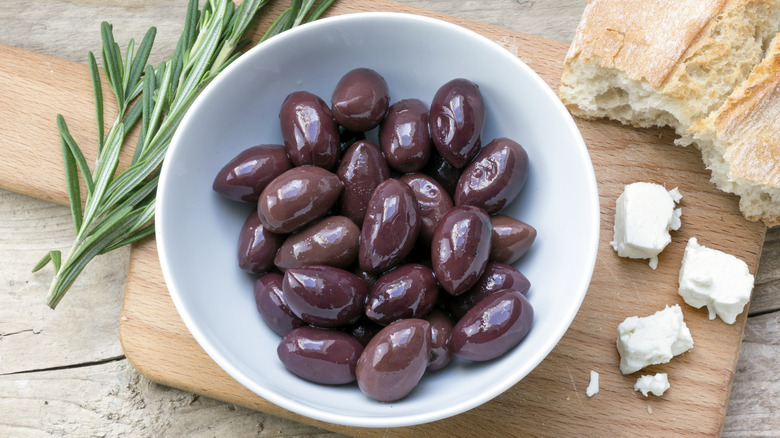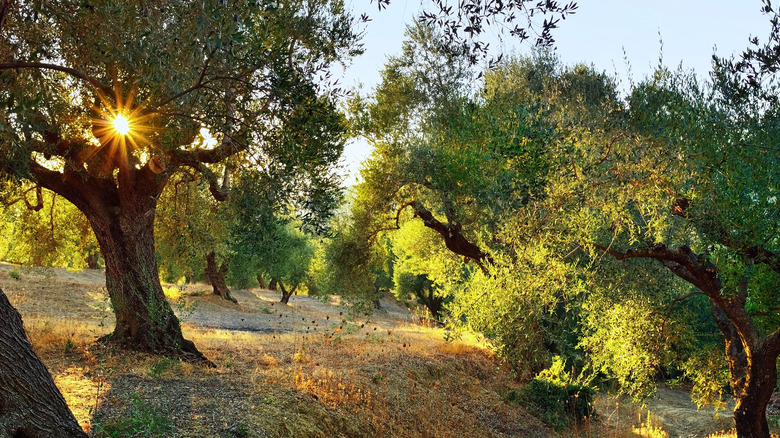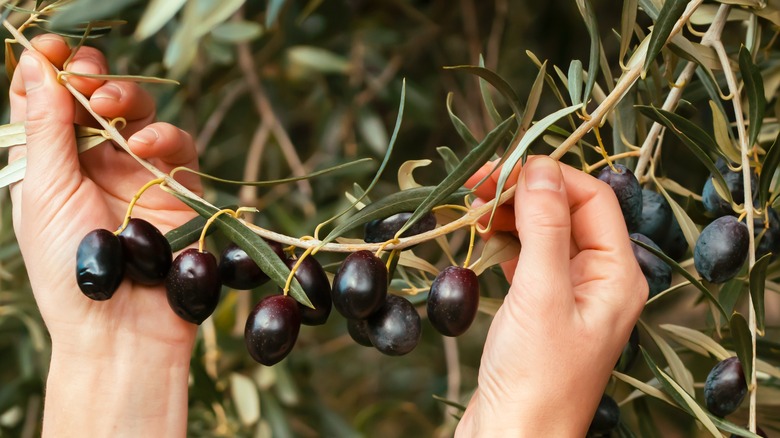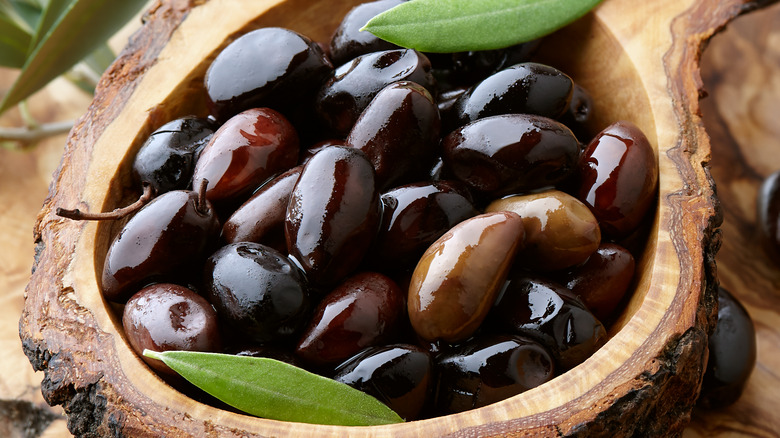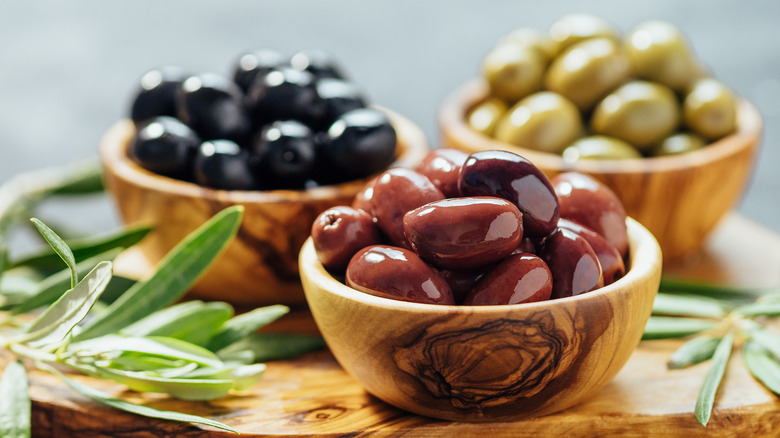What Makes Kalamata Olives Unique?
When looking at the most popular foods in the world, we see a lineup of the usual suspects. There's wheat, beef, poultry, chicken eggs, potatoes, corn, and rice (via All Top Everything). There is, however, one glaring omission. According to The Olive Oil Source, the olive, which has been with us for over 6,000 years, has been a consistent favorite amongst the founding cultures of Western civilization. The Ancient Greeks, in particular, mythologized olives to such an extent that it is said that the olive tree that grows at the Acropolis was planted by the goddess Athena herself.
Of course, when it comes to olives, everyone has their favorites. Spain has the manzanilla. Calabria, Italy — the tip of the boot for map reference — has the Leucocarpa, whose rendered oil was once considered so pure it was used to coronate emperors. And, of course, there is the Kalamata. Likely one of the most recognized olives in the entire world, Kalamata's are unique among their brethren due to where they are grown, how they are harvested, and their iconic, unmistakable taste (via Taste Atlas).
Where do Kalamata olives come from?
Though lagging behind Turkey, Morocco, Italy, and Spain, Greece is nevertheless a highly respected, leading producer of olives, harvesting around 1.2 million tons per year. Greece is home to over 60 different olive varieties. The little fruits have been a part of Greek culture and cuisine since the days of Socrates (via Atlas Big and Greek Flavours). However, if there is one Greek olive that everyone is familiar with, it is the Kalamata, and they are a key component of the Greek diet.
Kalamata olives are of the Kalmon variety and grown in and around the town of Kalamata. This coastal town sits comfortably in the region of Messinia in Greece's southern Peloponnese, according to Culture Trip. This area sees plenty of Mediterranean heat and sunshine, which is an environment where olives thrive. They are also legally protected with PDO status from the European Union. Essentially, no olives can be called Kalamata olives if they are not grown in this small, specific region. This is a common practice among European nations whose ingredients are very much a part of their history, like Greece and Italy. The PDO label gives the Kalamata legal protection from anyone attempting to sell olives that have not been produced in the specific region (via the E.U. Commission).
Growth, harvest, and brine
Kalamata olives are known for their almond-like shape and dark purple skin. The trees on which they grow have leaves that are much larger than the silvery spindles of most olive trees. The Kalamata olives are kept on the trees well longer than most other olives. While many olives are picked while the skin is still green, Kalamata's are picked later in the season, after their skin has turned dark. This ensures perfect ripeness, which is critical to preserve much of the Kalamata's characteristics. They are harvested in the late fall, typically between October and December, and picked by hand to ensure that the olive skin is not bruised (via Greek Flavours and Musco Food Corp.).
As with most olives, if you eat a Kalamata right off of the tree, you'll be puckering. Olives are naturally bitter, which is why they are so heavily seasoned if they are destined to become edible. This is achieved with the help of a brine. With the Kalamata olives, as Greek Flavors notes, you can either soak them in brine for a week, then pack them in another brine solution of wine vinegar, lemon wedges, and olive oil or you can soak them in a water solution that is 10% salt water and allow them to ferment for upwards of three months. This process greatly improves their taste.
Taste and health benefits
Once they are removed from their brine, the Kalamata olives are ready to be eaten. They lose none of their shiny, firm appearance having been submerged in liquid for so long. They're not shriveled like France's Nyons olives but maintain their general almond shapes. The Kalamatas are typically preserved with some kind of wine vinegar and olive oil, which imparts them with a smoky, fruity taste that is very rich and salty. They are an excellent olive option for tapenade, or simply sharing across the table amongst friends, per Serious Eats.
Kalamata olives are also surprisingly nutritious and beneficial to your overall health. Healthline explains that they are a great source of iron, copper, vitamins A and E, calcium, and oleic acid, which can help improve heart health. Greek Flavours also states that kalamata olives can promote skin health, stimulate metabolism, and help protect nerve cells from being damaged. We always hear that some newfangled fruit like the açaí berry is the next great superfood. Well, olives have been the Mediterranean's superfood for 6,000 years.
A different kind of olive
There is a general amount of conflation between common black table olives and Kalamata olives. According to Greek Flavours, while the Kalamata is a variety of black olive, owing to their taste and shape, they should not be confused with your standard, more mildly flavored black olives. Also, take note of the color difference. Black olives are, obviously, black, while Kalamata's are a very dark shade of purple.
When compared to other Greek olives, like the green, robust, and spicy Chalkidiki, the Kalamata has its own unique character. They typically pair well with some salty Feta cheese and a nice glass of white wine to offset the rich saltiness of both. And while other olives, like Italy's meat-stuffed Oliva Ascolana del Piceno, can be overburdened with added flavorings, the Kalamata olive really does stand out on its own (via Taste Atlas). Though it is a richly flavored olive, apart from the simple brine, there is not much else one can or should do with a Kalamata olive besides sit back and enjoy this plucky little Greek treasure.
